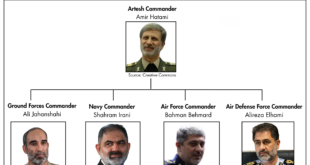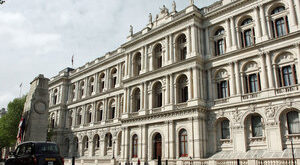On October 14, four days after Israel and Hamas agreed to phase one of US President Donald Trump’s 20-Point Ceasefire Plan for Gaza, Trump addressed the Israeli Knesset. “After so many years of unceasing war and endless danger, today the skies are calm, the guns are silent, the sirens are still, and the sun rises on a Holy Land that is finally at peace,” Trump stated. However, a month after the implementation of the first phase of the ceasefire, which laid out clear guidelines for the cessation of hostilities and the return of Israeli hostages, Hamas and allied terror groups have violated the agreement at least 18 times, the Israel Defense Forces (IDF) claims.
Phase one of the peace agreement laid out terms for exchanging the remaining Israeli hostages held by Hamas, living and deceased, for Palestinian detainees in Israeli prisons. In addition, the IDF had to withdraw to the “Yellow Line,” a delineated temporary border separating Hamas-controlled sections of Gaza—mainly in the central portion of the territory—from IDF-controlled areas. Hamas was given 72 hours to release all hostages, alive and deceased, and “exert maximum effort to ensure the fulfilment of these commitments as soon as possible.”
Since the agreement was signed, presumed Hamas terrorists entrenched in the Rafah area, which remains under IDF control, have attacked Israeli soldiers on two separate occasions, killing three. The group has also delayed the return of some deceased hostages; in one case, staging a false recovery. The IDF responded to both Rafah attacks by launching airstrikes across Gaza that eliminated dozens of Hamas members.
Below is a list of violations of the ceasefire by Hamas and other Palestinian terrorist groups between October 10 and November 6 that the IDF has reported:
- On October 13, the Arrow Unit, an internal security force established by the Hamas-run Ministry of Interior in Gaza, killed 32 Gazans whom it claimed collaborated with Israel, including members of the rival Doghmush clan. Though the prohibition of Hamas violence against Palestinians was not an explicit clause of the peace deal, US Central Command (CENTCOM) Commander Admiral Brad Cooper warned Hamas on October 15 “to immediately suspend violence and shooting at innocent Palestinian civilians in Gaza—in both Hamas-held parts of Gaza and those secured by the IDF behind the Yellow Line [that demarcates Israeli-held territory in Gaza].”
- On October 14, Hamas had yet to return over half of the remaining slain hostages, violating the ceasefire’s requirement that all hostages, living and dead, be handed over within 72 hours of the deal being signed. As of this publication, Hamas still holds the bodies of six hostages in continued violation of the agreement.
- According to the IDF, later on October 14, multiple “suspects” crossed the Yellow Line. The IDF said that the breach of territory represented a violation of the ceasefire, and that soldiers opened fire to remove the threat. The Hamas-run health ministry claimed that six Palestinians were killed in the two incidents on October 14.
- On October 15, Hamas further violated the requirement to return the bodies of slain hostages by handing over a body that “[did] not match any of the hostages,” according to Israel’s National Institute of Forensic Medicine.
- Hamas continued violence against Gazans on October 15 by publicly executing eight captives, including some members of the Doghmush clan. In response, Trump warned on October 16 that “if Hamas continues to kill people in Gaza, which was not the Deal, we will have no choice but to go in and kill them.”
- According to the Israeli military, on October 18, a “suspicious vehicle” crossed the Yellow Line and approached Israeli soldiers, drawing IDF fire. Hamas claimed that 11 members of a Palestinian family were killed in the incident.
- On October 19, Palestinian terrorists emerged from tunnels in Rafah and ambushed IDF soldiers, killing two and wounding three. Israel asserted that the attack, likely carried out by isolated pockets of Hamas fighters in Rafah, represented “a blatant violation of the ceasefire agreement,” while Hamas denied responsibility. Trump once again threatened Hamas on October 20, warning that the US had “made a deal with Hamas that they’re going to be very good, they’re going to behave, they’re going to be nice. […] And if they’re not, we’re going to go and we’re going to eradicate them if we have to.”
- On October 27, after a week of relative calm, Hamas returned the partial remains of a hostage whose body had previously been recovered by the IDF, and was therefore not considered one of the deceased hostages on the list of those to be released. Israeli Prime Minister Benjamin Netanyahu’s office called the event “a clear violation of the [Gaza ceasefire] agreement.”
- Also on October 27, the IDF released footage of Hamas staging the recovery of a hostage’s body. Hamas terrorists had used an excavator to pretend to search for the body, then dragged the corpse from a building, put it in a hole dug by the excavator, and notified the Red Cross that they had unearthed the remains. The incident cast doubt on Hamas’s continued statements that the group does not know where all the slain hostages are located. Israeli Minister of Diaspora Affairs Amichai Chikli said that Hamas does “not respect the deal. And obviously, we need to respond to all these violations of the ceasefire.” Chikli was likely referring to the aforementioned clause in phase one of the ceasefire plan that requires Hamas to “exert maximum effort” in recovering and returning the bodies of deceased hostages.
- On October 28, Israel blamed Hamas for a sniper and rocket-propelled grenade (RPG) attack that killed one IDF soldier, once again in the Rafah area. Hamas once again denied responsibility.
- On October 29, the IDF identified a site in Beit Lahia that it said was “storing weapons and aerial means intended for an imminent attack on IDF soldiers and the State of Israel.” The IDF said it struck the site in accordance with its mission to “continue to remove immediate threats” to troops.
- On November 1, Hamas handed over three bodies of those it claimed to be deceased hostages. However, none of the three sets of remains belonged to any of the hostages, according to Israeli Prime Minister Benjamin Netanyahu’s office.
- On November 2, the IDF said it identified a terrorist who had crossed the Yellow Line and was approaching Israeli troops in northern Gaza. The IDF said that “following the identification, and in order to remove the threat to the troops, the [Israeli Air Force] struck the terrorist.”
- A nearly identical incident happened on November 3. However, this time, multiple individuals crossed the Yellow Line “and advanced toward IDF troops in southern Gaza, posing an immediate threat to them,” according to the IDF, which added that Israeli troops fired on them “to remove the threat to the troops.”
- Also on November 3, Israel assessed that approximately 200 Hamas fighters were located in tunnels within Israeli-controlled areas of southern Gaza, including Rafah. Hamas terrorists had been required to withdraw from the area immediately upon the ceasefire’s implementation.
- On November 4, the IDF stated that a terrorist once again crossed the Yellow Line and approached Israeli troops. According to the IDF, “the terrorist was eliminated.”
- On November 5, in two separate instances, the IDF reported that “two terrorists were identified crossing the yellow line and advancing toward IDF troops in central Gaza.” The IDF eliminated the individuals.
In an effort to maintain the ceasefire, CENTCOM, in coordination with Israel, established a Civil-Military Coordination Center on October 17 that is “designed to support stabilization efforts.” CENTCOM noted that approximately 200 US service members “with expertise in transportation, planning, security, logistics, and engineering” were stationed at the hub. Though not explicitly labeling the incident a ceasefire violation, a CENTCOM MQ-9 Reaper drone captured footage of Hamas terrorists looting an aid truck on October 31. The documentation of such an incident suggests that the Civil-Military Coordination Center will play a significant role in logging future violations.
 Eurasia Press & News
Eurasia Press & News




